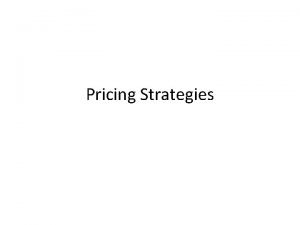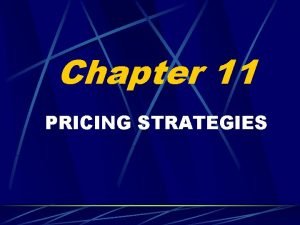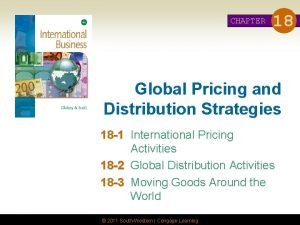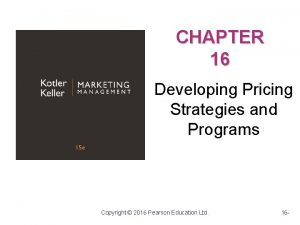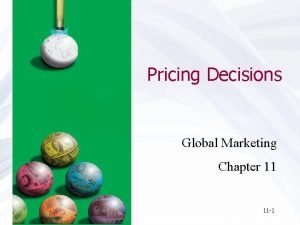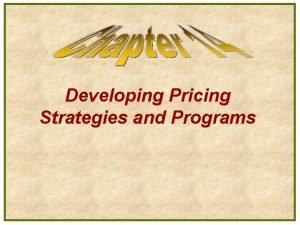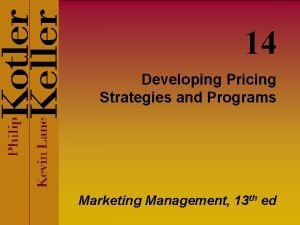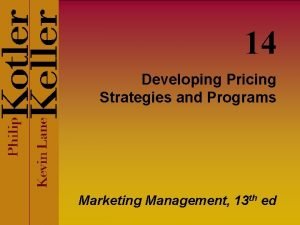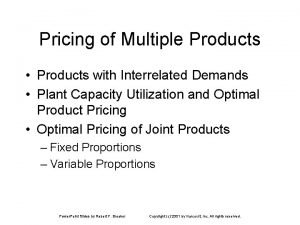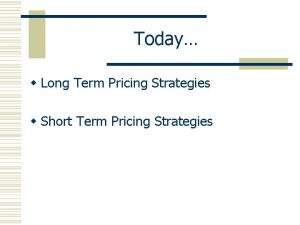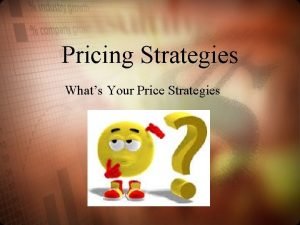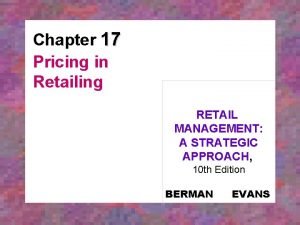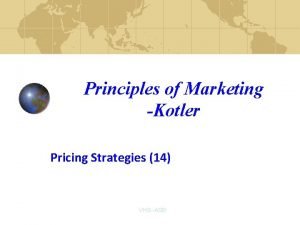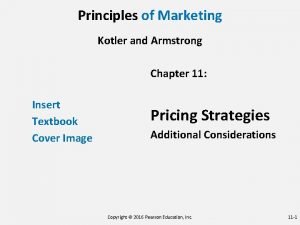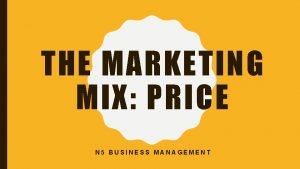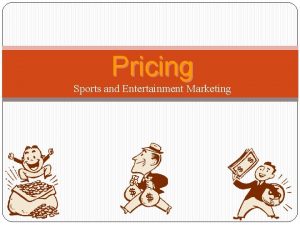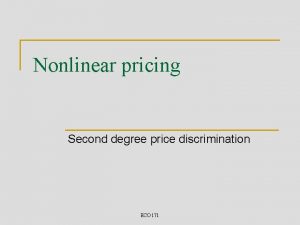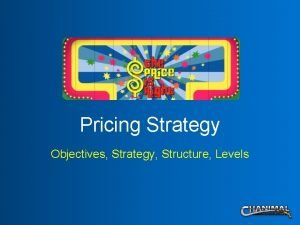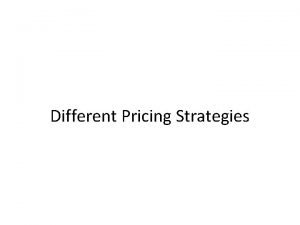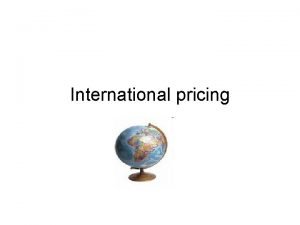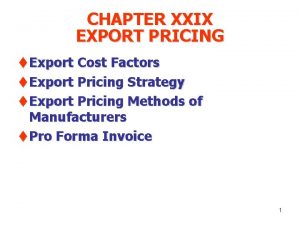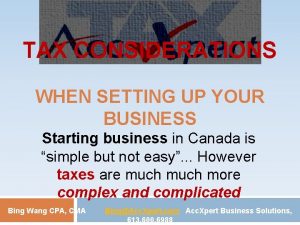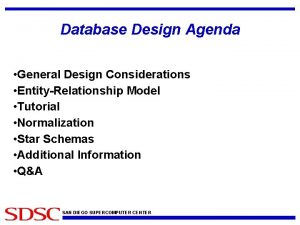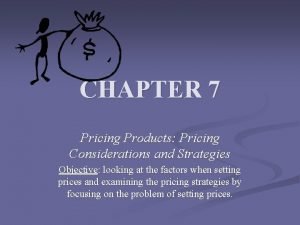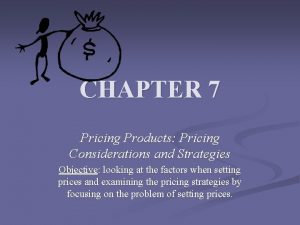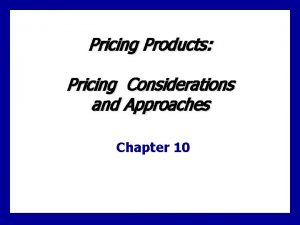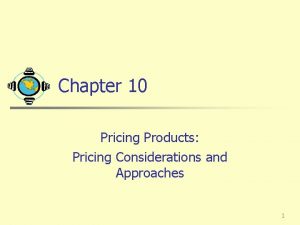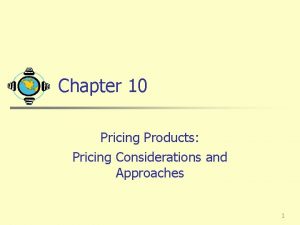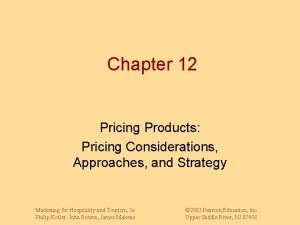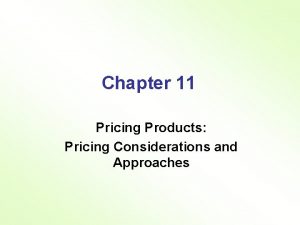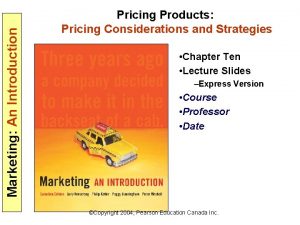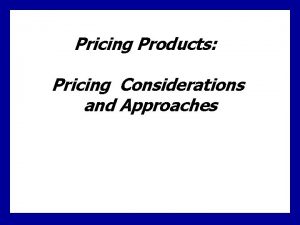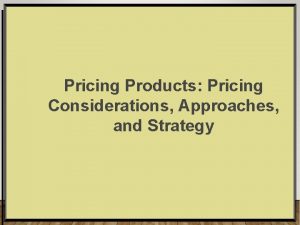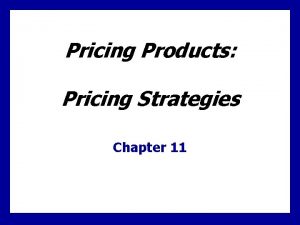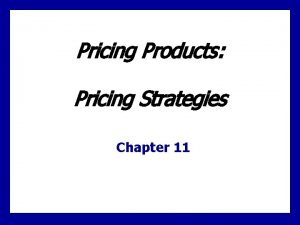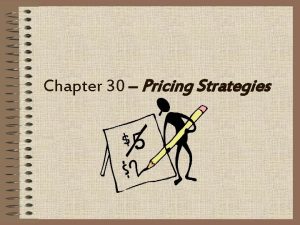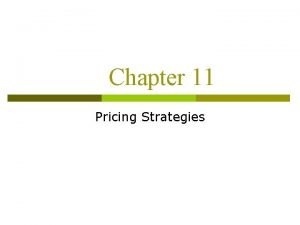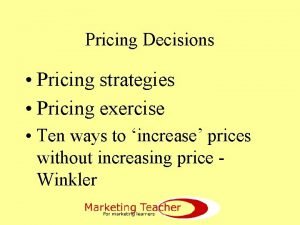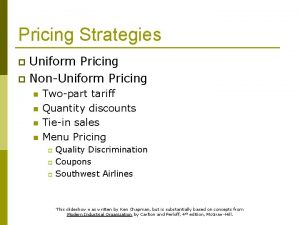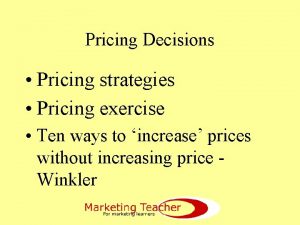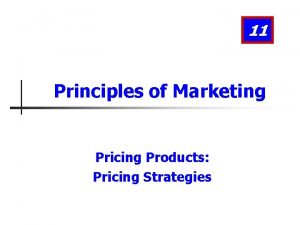CHAPTER 6 Pricing Products Pricing Considerations and Strategies












































- Slides: 44

CHAPTER 6 Pricing Products: Pricing Considerations and Strategies Objective: looking at the factors when setting prices and examining the pricing strategies by focusing on the problem of setting prices.

Factors to Consider When Setting Prices A company’s pricing decisions are affected by; • internal company factors • external environmental factors

Internal Factors Affecting Pricing Decisions • • Internal factors that affect pricing decisions include; the company’s marketing objectives marketing-mix strategy costs organization

Marketing Objectives • Before setting a price, the company must decide on its overall strategy (target market, and positioning, then its marketing mix). E. g. if a car manufacturer decides to produce a new sports car for the high-income segment, then the company must charge a high price. • Then the company must consider its objectives, before setting its price. Objectives would be; – survival; if a company is in trouble because over capacity, heavy competition, or changing consumer wants, in order to survive and increase demand, the

company may set a low price. Here, the profits are less important than survival. If the prices cover the costs, they can stay in business but survival is only a shortterm objective. – current profit maximization; some companies estimate what demand costs will be at different prices and choose the price that will produce the maximum current profit. Here, short-term financial results (cash flow) are more important than long-run performance. – market-share leadership; some companies believe that the company with largest market share will enjoy the lowest costs and highest long-run profit. That is why, in order to become the market-share leader, they set their prices as low as possible. – product-quality leadership; if a company wants to become the product-quality leader, it charges a high price to cover the costs of R&D.

Marketing-Mix Strategy • Decisions made for the other marketing mix variables affect pricing decisions. The marketer must consider the total marketing mix when setting prices. • There are two alternatives. Either price positioning determines the product’s marketing mix or nonprice positioning determines the product’s marketing mix. – In price positioning; the company makes its pricing decision first and then makes other marketing-mix decisions on the prices that they want to charge. This

technique is called target costing which reverses the usual process of first designing a new product, determining its cost, and then asking the consumers how much they can pay for it. Instead it starts with a target cost and price in mind and works back. E. g. Compaq Computer Corporation calls this process “design to price”. Starting with a price target set by marketing, and with profit margin goals from management, the company determine what costs had to be in order to charge the target price for its “Prolinea personal computer line”. – In nonprice positioning; the company deemphasize price and use other marketing-mix tools to differentiate the marketing offer to make it worth a higher price. They believe that the best strategy is not to charge the lowest price because customers do not buy on price alone. Instead they seek products that give them the best value for their money.

Costs • Costs set the floor for the price that the company can charge for its product. The company wants to charge a price that both covers all its costs for producing, distributing, and selling the product and provides a fair profit. • A company’s costs are two types: fixed and variable.

– Fixed costs (also known as overhead) are those that do not vary with production or sales level e. g. rent, interest, heat, executive salaries. – Variable costs vary directly with the level of production e. g. supplies. – Total costs are the sum of the fixed and variable costs for any given level of production. Management wants to charge a price that will at least cover the total production costs at a given level of production.

Organizational Considerations • Management must decide who will set the prices in the company. • In small companies, prices are set by the top management. • In large companies prices are set by divisional or product line managers. • In industrial markets, salespeople may be allowed to negotiate with customers within certain price ranges set by the top management. • In industries where pricing is a key factor (railroads, oil companies…) there are pricing departments reporting to the marketing department or top management.

External Factors Affecting Pricing Decisions External factors that affect pricing decisions include; • the nature of the market and demand • competition • other environmental elements

The Market and Demand • Before setting prices, the marketer must understand the relationship between price and demand for its product with the help of the following; – pricing in different types of markets – consumer perceptions of price and value – analyzing the price-demand relationship

Pricing in Different Types of Markets • The seller’s pricing freedom varies with different types of markets. Economists recognize four types of markets which require different pricing methods. – under pure competition; the market consists of many buyers and sellers trading in a uniform commodity such as wheat, copper… No single buyer or seller has much effect on the going price. A seller cannot charge more than the going price because buyers can obtain as much as they need at the going price. A seller cannot charge less as well, because they can sell all they want at this

price. Here, marketing research, product development, pricing, advertising and sales promotion play little or no role. – under monopolistic competition; the market consists of many buyers and sellers who trade over a range of prices than a single market price. A range of prices occurs when buyers see differences in sellers’ products and are willing to pay different prices form them. Sellers try to develop differentiated offers (with advertising, branding…) for different customer segments. – under oligopolistic competition; the market consists of a few sellers who are highly sensitive to each other’s pricing and marketing strategies. The product can be uniform (steel, aluminum. . . ) or nonuniform (cars, computers…). There are few sellers because it is

difficult for new sellers to enter the market. Each seller is alert to competitors’ strategies and moves. If a steel company decreases its price by 10 percent, buyers quickly switch to this supplier. So that the other steelmakers must respond by lowering their prices or increasing their services. Here it is not certain that they will get permanent results through such price cuts. – In a pure monopoly, the market consists of one seller. It would be a government monopoly, a private regulated monopoly, or a private nonregulated monopoly. Pricing is handled differently in each case. A government monopoly may have three objectives. (1) It might set a price below cost because the product is important for the buyers who cannot afford to pay full cost. (2) Or the price might be set either to cover costs

or to produce good revenue. (3) It can be set quite high to slow down consumption. In a regulated monopoly, the government permits the company to set rates (but that should yield a “fair return”). In a nonregulated monopoly, the company is free to set a price at what the market will bear. But they may not charge the highest price for a number of reasons: (1) not to attract competition, (2) to penetrate the market faster with a low price, or (3) to prevent government regulation.

Consumer Perceptions of Price and Value • The consumer decides whether a product’s price is right. That is why, pricing decisions are buyer oriented like the other marketing-mix decisions. • Effective buyer-oriented pricing involves understanding how much value consumers give to the product and setting a price that fits this value. But is not easy to measure the value (intangible values are included e. g. taste, environment, status…) that consumers give to the product. • If consumers perceive that the price is greater than the product’s value, they do not buy the product. If consumers perceive that the price is below the product’s value, they but then the seller loses from its profit opportunities.

Analyzing The Price-Demand Relationship • Each price that the company might charge will lead to a different level of demand. • In the normal case, demand price are inversely related: the higher the price, the lower the demand. • In the case of prestige goods, the demand curve sometimes slopes upward e. g. one perfume company found that by raising its price, it sold more perfume rather than less. Consumers thought that the higher price meant a better perfume. • Most companies try to measure their demand curves by estimating demand at different prices.

Price Elasticity of Demand • Marketers need to know price elasticity - how responsive demand will be to a change in price. If demand hardly changes with a small change in price, we say that the demand is inelastic. If demand changes greatly, we say that the demand is elastic. • Buyers are less price sensitive; – when the product is unique or high quality or prestige – when substitute products are hard to find or when they cannot easily compare the quality of substitutes

– when the total expenditures for a product is low relative to their income or when the cost of buying a product is shared by another party. • If demand is elastic, sellers lower their price. A lower price produces more total revenue when the extra costs of producing and selling do not exceed the revenue. A. Inelastic demand P 2 P 1 B. Elastic Demand P 2 P 1 Q 2 Q 1 Quantity demanded per period

Competitors’ Costs, Prices, and Offers • Another external factor affecting the company’s pricing decisions is competitors’ costs and prices and reactions to the company’s own pricing moves. • The company’s pricing strategy may affect the nature of the competition e. g. if a company follows a highprice strategy, it may attract competition. A low-price strategy may stop competitors or drive them out of the market. Here, the company must learn the price and quality of each competitor’s offer and price its offer relative to competition.

Other External Factors Some other factors must be considered when pricing; • economic conditions; such as boom or recession, inflation, and interest rates affect pricing because they affect (1) the costs of production and (2) consumer perceptions of the product’s price and value. • resellers; should be considered in pricing because they should get a fair profit so that they help the company to sell its products.

• government; laws that affect pricing must be known so that the company makes sure that their pricing policies are defensible. • social concerns; the company’s sales, market share, profit goals must be viewed by societal considerations.

General Pricing Approaches • Companies set prices by selecting a general pricing approach that includes one or more of the following factors: (1) product cost, (2) consumer perceptions of the product’s value - demand, (3) competitor’s prices and other external and internal factors. • Following pricing approaches are possible to use; – the cost-based approach (cost-plus pricing, break-even analysis, and target profit pricing) – the buyer-based approach (value-based pricing) – the competition-based approach (going-rate and sealed-bid pricing)

Major Considerations in Setting Price LOW PRICE No possible profit at this price Product costs Competitor’s prices and other external and internal factors Consumer perceptions of value HIGH PRICE No possible demand at this place

Cost-Based Pricing Cost-plus pricing “markup pricing” • is the simplest pricing method in which a standard mark-up (profit margin) is added to the cost of the product e. g. the cost of producing a toaster is $16 and the producer wants to make a 25% profit, therefore sets the price at $20. • the biggest benefits of this approach is that when all the companies use this approach, price competition is minimized.

Break-even pricing or target profit pricing • in which the firm tries to determine the price at which it will break even or make the target profit that it wants. • Target pricing uses the concept of a break-even chart, which shows the total cost and total revenue expected at different sales volume levels. • E. g. fixed costs are $6 million, variable costs are $5 per unit. The total revenue curve reflects the price. If the revenue is $12 million on 800. 000 units, the price is $15 per unit.

At the $15 price, the company must sell at least 600. 000 units to break even where the total revenues equal to total costs, $9 million. If the company wants to target $2 million profit, it must sell at least 800. 000 units to obtain $12 million total revenue needed to cover $10 million total costs. • The higher the price, the lower the company’s break-even point. But as the price increases, demand decreases. Although this approach helps the company to determine minimum prices needed to cover its expected costs and profits, they do not take the price-demand relationship into consideration.

Break-even Chart for Determining Target Price Dollars Total revenue Target profit ($2 million) 12 10 8 6 4 2 0 Total cost Fixed cost 200 400 600 800 1000 Sales volume in units (thousands)

Buyer-Based Pricing • uses buyer’s perceptions of value as the key to pricing. Here, the marketer set the price based on the consumer’s desires and then design the product and the other marketing-mix variables. • Cost-based pricing is product driven, but buyer -based pricing is consumer driven. Therefore, it begins with analyzing consumer needs and value perceptions.

Competition-Based Pricing Going-rate pricing • in which a firm bases its prices on competitor’s prices. The firm might charge the same, more or less than its competitors. • Going-rate pricing is popular when elasticity of demand is hard to measure and when the firms do not want harmful price wars.

Pricing Strategies Basic pricing strategies are; • New-product pricing • Product-bundle pricing • Price-adjustment pricing

New-Product Pricing Strategies • Pricing strategies usually change as the product passes through its life-cycle. At the introduction stage, basically there are three types of pricing for new products; – prestige pricing – market-skimming pricing – market-penetration pricing

Prestige Pricing • Hotels or restaurants seeking to position themselves as luxurious and elegant will enter the market with a high price. This is called prestige pricing. Some nightclubs may charge high prices to attract a certain type of customers. E. g. Sherlock Holmes. Market-Skimming Pricing • When a new product is introduced, the company charges the highest price that it can to skim (as skimming the cream on the top of the fresh milk) the market. The objective is to earn the highest possible gross profit. As initial sales slow down,

and competitors start to introduce similar products, the company must lower its prices. • Here, the company skim off small but profitable market segments. • Market skimming makes sense; (1) when the product’s quality and image support its high price and enough buyers want it at that price, (2) when the costs of producing a smaller volume are not so high that they eliminate the advantages of charging more, (3) when competitors do not enter the market easily and cut the prices.

Market-Penetration Pricing • Market-penetration pricing is that setting a low price for a new product in order to attract a large number of buyers and a large market share. • The high sales volume results in falling costs which helps the company to cut its price even more. • Market-penetration makes sense; (1) when the market is price sensitive (2) when production and distribution costs fall as sales volume increases, (3) when the low price keeps the competitors away.

Product-Bundle Pricing • Sellers who use product-bundle pricing combine several of their products and offer the bundle at a reduced price. For example, hotels sell specially priced weekend packages that include room, meals, and entertainment. Fast food restaurants offer “menus” that include hamburger, french fries and a drink. Package tour of travel agencies include hotel accommodation, transportation and meals. • Price bundling can promote the sales of of products consumers might not otherwise buy, but the combined price must be low enough to convince them to buy the bundle.

Price-Adjustment Strategies • Companies adjust their prices according to the differences in customers and changing situations. There are several price adjustment strategies; – discount pricing – discriminatory pricing – psychological pricing – promotional pricing

Discount pricing • Volume discounts: Most hotels have special rates to attract customers who may purchase a large quantity of hotel rooms. Hotels usually offer specials prices for travel agencies (group rate), meeting planners and companies (corporate). • Discounts based on time of purchase: Hotels, motels and airlines offer seasonal discounts, when the demand is lower. Seasonal discounts allow the hotel to keep demand steady during the year.

Discriminatory pricing Adjusting the basic prices to allow differences in customers, products, and locations. In this approach, the company sells a product or service at two or more prices. There are different discriminatory pricing forms; • in customer-segment pricing; different customers pay different prices for the same product or service e. g. museums charge students and senior citizens lower, hotels charge rack rate, corporate, children rate… The least price sensitive customers are offered the highest prices. • in product-form pricing; different versions of the product are priced differently but not according to differences in their costs e. g. the most favorite or

top model of the product line may have higher price. • in location pricing; a company charges different prices for different locations, even though the cost of offering each location is the same e. g. theatres vary their seat prices, hotels vary their room prices based on the room’s view. Yield Management One application of discriminatory pricing is yield management. A yield management system is used to maximize a hotel’s revenue. If low occupancy is projected, the hotel will keep lower rates to increase occupancy. The idea is to create extra

demand with low rates attracting guests that the hotel would not have received otherwise. If the projected occupancy is high, the lower rates will be closed and only the high rates will be offered to maximize revenue. Psychological Pricing Price says something about the product, especially about its quality. • in psychological pricing; sellers consider the psychology of prices rather than economics.

• The difference between $300 and $299. 95 is just five cents but the psychological difference can be much greater. Some consumers will see the $299. 95 as a price in the $200 range rather than the $300 range. Promotional pricing Temporarily pricing products below list price, and sometimes even below cost, to increase short-run sales. There are several forms; • loss leaders; fast-food restaurants price a few items as loss leaders to attract customers to the store in the hope that they will buy other items at the normal price. Casinos offer free rooms to their gaming customers.

• special-event pricing; during slow periods, hotels may offer a special promotional rate to increase business. Rather than just discount prices, wellmanaged hotels will create special events. A Valentine’s weekend special including a room, champagne upon arrival, a dinner for two, and breakfast in the room.
 Writing strategies and ethical considerations
Writing strategies and ethical considerations Pricing considerations and approaches
Pricing considerations and approaches Chapter 26 pricing strategies answer key
Chapter 26 pricing strategies answer key Price adaptation strategies
Price adaptation strategies Chapter 26 pricing strategies
Chapter 26 pricing strategies Basal state specimen
Basal state specimen Functional and innovative products
Functional and innovative products Pricing and distribution strategies
Pricing and distribution strategies Developing pricing strategies and programs ppt
Developing pricing strategies and programs ppt Global pricing objectives and strategies
Global pricing objectives and strategies Developing pricing strategies and programs
Developing pricing strategies and programs Developing pricing strategies and programs
Developing pricing strategies and programs Developing pricing strategies and programs
Developing pricing strategies and programs Coke vs pepsi sales
Coke vs pepsi sales Ethical consideration in experimental research sample
Ethical consideration in experimental research sample Multi product pricing
Multi product pricing Destroyer pricing
Destroyer pricing Optional product pricing meaning
Optional product pricing meaning Differential pricing strategy
Differential pricing strategy Pricing in retailing
Pricing in retailing Retail price management
Retail price management Kotler pricing strategy
Kotler pricing strategy Captive product pricing example
Captive product pricing example 5 marketing mix
5 marketing mix Deposit pricing strategies
Deposit pricing strategies Starbucks marketing mix
Starbucks marketing mix Entertainment pricing strategies
Entertainment pricing strategies 171
171 Physical rate fences
Physical rate fences Pricing strategies in marketing
Pricing strategies in marketing Pricing strategies definition
Pricing strategies definition Penetration pricing
Penetration pricing International pricing strategies
International pricing strategies Factors affecting export pricing
Factors affecting export pricing General considerations in machine design
General considerations in machine design Tax considerations for setting up a new business
Tax considerations for setting up a new business Atm kiosk software
Atm kiosk software Three considerations of societal marketing concept
Three considerations of societal marketing concept Mechanical considerations of transmission line
Mechanical considerations of transmission line Database design considerations
Database design considerations Neurological considerations in language acquisition
Neurological considerations in language acquisition Cloud delivery model considerations
Cloud delivery model considerations Bioreactor considerations for animal cell culture
Bioreactor considerations for animal cell culture Collaboration design considerations
Collaboration design considerations Fpd tooth preparation
Fpd tooth preparation


